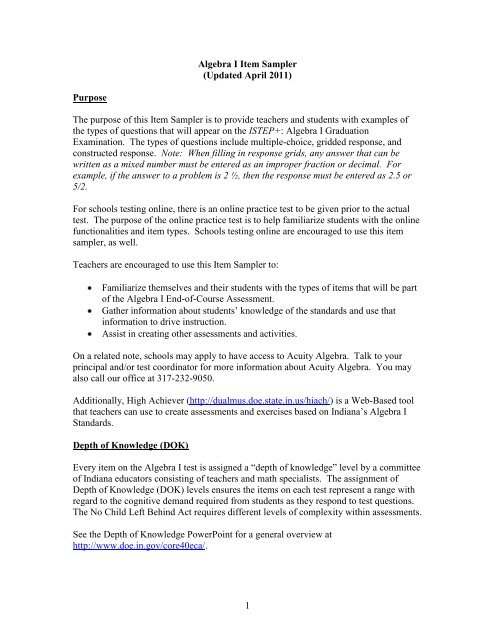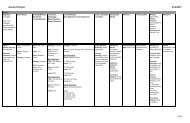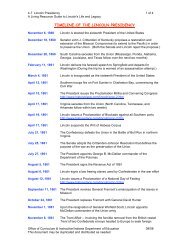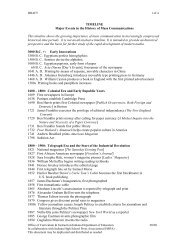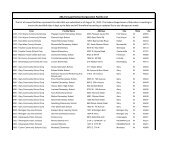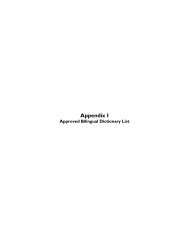Algebra I Item Sampler - Indiana Department of Education
Algebra I Item Sampler - Indiana Department of Education
Algebra I Item Sampler - Indiana Department of Education
Create successful ePaper yourself
Turn your PDF publications into a flip-book with our unique Google optimized e-Paper software.
<strong>Algebra</strong> I <strong>Item</strong> <strong>Sampler</strong><br />
(Updated April 2011)<br />
Purpose<br />
The purpose <strong>of</strong> this <strong>Item</strong> <strong>Sampler</strong> is to provide teachers and students with examples <strong>of</strong><br />
the types <strong>of</strong> questions that will appear on the ISTEP+: <strong>Algebra</strong> I Graduation<br />
Examination. The types <strong>of</strong> questions include multiple-choice, gridded response, and<br />
constructed response. Note: When filling in response grids, any answer that can be<br />
written as a mixed number must be entered as an improper fraction or decimal. For<br />
example, if the answer to a problem is 2 ½, then the response must be entered as 2.5 or<br />
5/2.<br />
For schools testing online, there is an online practice test to be given prior to the actual<br />
test. The purpose <strong>of</strong> the online practice test is to help familiarize students with the online<br />
functionalities and item types. Schools testing online are encouraged to use this item<br />
sampler, as well.<br />
Teachers are encouraged to use this <strong>Item</strong> <strong>Sampler</strong> to:<br />
Familiarize themselves and their students with the types <strong>of</strong> items that will be part<br />
<strong>of</strong> the <strong>Algebra</strong> I End-<strong>of</strong>-Course Assessment.<br />
Gather information about students’ knowledge <strong>of</strong> the standards and use that<br />
information to drive instruction.<br />
Assist in creating other assessments and activities.<br />
On a related note, schools may apply to have access to Acuity <strong>Algebra</strong>. Talk to your<br />
principal and/or test coordinator for more information about Acuity <strong>Algebra</strong>. You may<br />
also call our <strong>of</strong>fice at 317-232-9050.<br />
Additionally, High Achiever (http://dualmus.doe.state.in.us/hiach/) is a Web-Based tool<br />
that teachers can use to create assessments and exercises based on <strong>Indiana</strong>’s <strong>Algebra</strong> I<br />
Standards.<br />
Depth <strong>of</strong> Knowledge (DOK)<br />
Every item on the <strong>Algebra</strong> I test is assigned a “depth <strong>of</strong> knowledge” level by a committee<br />
<strong>of</strong> <strong>Indiana</strong> educators consisting <strong>of</strong> teachers and math specialists. The assignment <strong>of</strong><br />
Depth <strong>of</strong> Knowledge (DOK) levels ensures the items on each test represent a range with<br />
regard to the cognitive demand required from students as they respond to test questions.<br />
The No Child Left Behind Act requires different levels <strong>of</strong> complexity within assessments.<br />
See the Depth <strong>of</strong> Knowledge PowerPoint for a general overview at<br />
http://www.doe.in.gov/core40eca/.<br />
1
Reference Sheet<br />
The <strong>Algebra</strong> I Reference Sheet may be used on both sessions <strong>of</strong> the <strong>Algebra</strong> I test.<br />
Teachers are encouraged to use the reference sheet throughout the year to familiarize<br />
students with the structure <strong>of</strong> and information contained in the reference sheet. The<br />
Reference Sheet can be accessed here http://www.doe.in.gov/assessment/eca_resources.html.<br />
Calculator Policy<br />
Students are allowed to use a calculator on one session <strong>of</strong> the <strong>Algebra</strong> I ECA. Students<br />
are not allowed to use a calculator on the other session unless specified in the student’s<br />
IEP or Section 504 plan. Students should use calculators with which they are familiar.<br />
Sharing <strong>of</strong> calculators is not allowed.<br />
The memory and stored programs and applications in each personal calculator should be<br />
cleared before and after testing. Students should be told prior to the test day to store all<br />
s<strong>of</strong>tware and data they wish to save on a computer or calculator not being used for the<br />
test.<br />
The prohibited calculator list below is not exhaustive. Changes in technology occur at a<br />
rapid pace; thus, it is very difficult to list all <strong>of</strong> the calculators not permissible. In<br />
general, calculators with a QWERTY keyboard, a computer algebra system (CAS), and<br />
talking devices are NOT allowed. Be sure to ask your mathematics department chair if<br />
you are unsure whether a particular calculator is allowed.<br />
Examples <strong>of</strong> Calculator Models NOT Allowed<br />
Models with QWERTY keypads, such as: TI-89, TI-92, TI-Voyage, HP 95<br />
Models with a computer algebra system (CAS) or dynamic algebra system, such<br />
as: TI-Nspire + CAS, HP 49G, Casio ClassPad 300<br />
Models with infrared devices<br />
Models with paper tapes<br />
Models that require an electrical outlet<br />
Models that make noise or “talk”<br />
Pocket organizers, handheld computers, laptop computers, electronic writing pads<br />
or pen-input devices, such as:<br />
o Palm Pilot, HP Jornada, Casio Cassiopeia, Handspring Visor, Audiovox<br />
Maestro, Compaq iPAQ, Sony CLIE PEG, Sharp Wizard, Sharp Zaurus,<br />
NEC Mobile Pro<br />
Cellular phones or other wireless communication devices, such as:<br />
o iPod touch<br />
2
Solving Linear Equations and Inequalities<br />
1. Solve: 5x + 12 = x – 4<br />
A. -4<br />
B. 8<br />
3<br />
C. 2<br />
D. 4<br />
3<br />
2. Solve 2(2 – x) ≤ -3x – 2 for x.<br />
A. x ≤ -6<br />
B. x ≤ -3<br />
C. x ≤ 2<br />
D. x ≥ 6<br />
3. Solve 5x – 10y = -40 for y.<br />
A. y = -2x – 4<br />
1<br />
B. y = x 4<br />
2<br />
1<br />
C. y = x 4<br />
2<br />
D. y = 2x + 4<br />
4. Solve:<br />
2x<br />
3 x<br />
4 4<br />
A. x = -3<br />
B. x = -1<br />
C. x = 1<br />
D. x = 3<br />
3
5. The formula A = ½ bh represents the area <strong>of</strong> a triangle where A represents the area, b<br />
is the base <strong>of</strong> the triangle and h is the height <strong>of</strong> the triangle.<br />
Solve this formula for b.<br />
A. b 2 A h<br />
B. b A 1 h<br />
2<br />
C. b<br />
A<br />
2h<br />
D. b<br />
2A<br />
h<br />
6. Megan bought 7 charms for $31.50. Each charm costs the same amount <strong>of</strong> money.<br />
Write an inequality that can be used to find the maximum amount <strong>of</strong> charms (c)<br />
Megan can buy with $75.<br />
Answer_________________________<br />
What is the maximum amount <strong>of</strong> charms Megan can buy with $75?<br />
Answer_________________________<br />
7. Solve<br />
3x<br />
5<br />
2x 1 for x.<br />
2<br />
Enter your answer in the response grid.<br />
4
8. Solve: x + 4.25 = 3.5x – 1.5x – 0.75<br />
Enter your answer in the response grid.<br />
9. Solve the inequality below for x.<br />
3<br />
4<br />
x<br />
2<br />
3x<br />
1<br />
A. x ≤<br />
B. x ≤<br />
C. x ≥<br />
D. x ≥<br />
4<br />
3<br />
4<br />
15<br />
4<br />
5<br />
4<br />
3<br />
10. The equation below was solved incorrectly. Study the work below.<br />
Step 1: 5x + 5 = -3x + 3<br />
Step 2: 2x = -2<br />
Step 3: x = -1<br />
5x + 5 = -3(x – 1)<br />
Describe the mistake in the work shown above.<br />
______________________________________________________________<br />
______________________________________________________________<br />
______________________________________________________________<br />
What is the solution to the equation 5x + 5 = -3(x – 1)?<br />
Answer____________________<br />
5
11. Tony works at a bike store. Tony earns $300 every week plus $15 for every bike that<br />
he sells.<br />
Write an inequality that can be used to determine the number <strong>of</strong> bikes (b) Tony must<br />
sell in one week if he wants to earn a minimum <strong>of</strong> $500 for that week.<br />
Answer____________________<br />
What is the minimum number <strong>of</strong> bikes Tony must sell in one week to earn a weekly<br />
salary <strong>of</strong> $500?<br />
Answer_____________________<br />
12. Alex sells T-shirts. It costs Alex $6.50 to buy each T-shirt. Alex also pays $150 each<br />
month to rent equipment to add print to the T-shirts.<br />
Alex sells each T-shirt for $12.<br />
Write an inequality that can be used to determine the number <strong>of</strong> T-shirts (T) Alex<br />
must sell each month in order to make a pr<strong>of</strong>it for the month. (Assume that Alex sells<br />
each T-shirt he buys.)<br />
Answer____________________<br />
What is the minimum number <strong>of</strong> T-shirts Alex must sell in order to make a pr<strong>of</strong>it in a<br />
given month? (Assume that Alex sells each T-shirt he buys.)<br />
Answer____________________<br />
6
13. Solve: -9 ≤ -2x + 3 ≤ 1<br />
A. 3 ≥ x ≥ -1<br />
B. 6 ≤ x ≤ 1<br />
C. 3 ≤ x ≤ -1<br />
D. 6 ≥ x ≥ 1<br />
Graphing and Interpreting Linear and Non-Linear Relations<br />
1. What is the domain and range <strong>of</strong> the relation shown in the table below?<br />
x y<br />
-1 -5<br />
1 -1<br />
3 3<br />
5 7<br />
Domain____________________<br />
Range_____________________<br />
Is the relation in the table above a function?<br />
Answer____________________<br />
2. Which relation below is NOT a function?<br />
A. { (-2, 4), (1, 3), (0, 4) }<br />
B. { (5, 5), (4, 4), (3,3) }<br />
C. { (-4, 0), (-7, 0), (11, 0) }<br />
D. { (1, 4), (2, 5) (1, 7) }<br />
7
3. Maria rode her bike home from school. The graph below shows Maria’s distance<br />
from school over time.<br />
Maria’s Bike Ride Home<br />
Describe Maria’s bike ride home with respect to time and distance. Be sure to include<br />
any changes in speed during the bike ride.<br />
4. Which equation has a graph with no y-intercept?<br />
A. y = 5<br />
B. x = 1<br />
C. x = y<br />
D. y = -x<br />
5. What is the slope, x-intercept, and y-intercept <strong>of</strong> the graph <strong>of</strong> 3x + y = 7?<br />
slope = _____ x-intercept = ______ y-intercept = _____<br />
8
6. What is the y-intercept <strong>of</strong> the graph <strong>of</strong> -2y = x – 4?<br />
A. -4<br />
B. -2<br />
C. 2<br />
D. 4<br />
7. Which <strong>of</strong> the following is an equation <strong>of</strong> a line with a slope <strong>of</strong> -2 that passes through<br />
the point (-4, 3)?<br />
A. y = -2x – 5<br />
B. y = -2x – 4<br />
C. y = -2x + 3<br />
D. y = -2x + 11<br />
8. Write an equation <strong>of</strong> a line that passes through the points (-2, 5) and (1, 2).<br />
Answer____________________<br />
9
2<br />
9. Graph: y x 1<br />
3<br />
10. Graph: 6x – 2y = 10<br />
y<br />
y<br />
x<br />
x<br />
1<br />
11. Graph: y x 4<br />
3<br />
12. Graph: -5y < 10x<br />
y<br />
y<br />
x<br />
x<br />
10
13. Sue earns $2 for each CD she sells and $2.50 for each DVD she sells. Sue<br />
earned $950 last week selling CDs and DVDs.<br />
Write an equation to represent the number <strong>of</strong> CDs (c) and DVDs (d) Sue sold last<br />
week given that she earned $950.<br />
Answer____________________<br />
If Sue sold 305 CDs last week, how many DVDs did she sell?<br />
Answer____________________<br />
14.Wes bought a pizza with 2 toppings from Bill’s Pizza Place for $11.00.<br />
Lisa bought a pizza with 5 toppings from Bill’s Pizza Place for $14.75.<br />
Each topping at Bill’s Pizza Place costs the same amount.<br />
What is the price per topping at Bill’s Pizza Place?<br />
Answer____________________<br />
Write an equation that can be used to determine the cost (C), in dollars, <strong>of</strong> a pizza at<br />
Bill’s Pizza Place given the number <strong>of</strong> toppings (T).<br />
Answer____________________<br />
11
15. Joe ran from his home to school at a constant speed. He immediately turned around<br />
and ran back home, but at a slower constant speed. Joe ran along a straight path to<br />
and from school. Which graph best represents Joe’s distance from his home over<br />
time?<br />
A. B.<br />
C. D.<br />
12
16. The graph below represents the total number <strong>of</strong> times a certain website was visited<br />
over a 5-day period.<br />
What is the slope <strong>of</strong> this line segment and what does it represent in terms <strong>of</strong> this<br />
situation?<br />
Write an equation that represents the total number <strong>of</strong> times this website is visited, V, after<br />
d days.<br />
Answer______________________________<br />
If this trend continues, how many times will this website be visited in 30 days?<br />
Answer______________________________<br />
13
1. Solve the system <strong>of</strong> equations below.<br />
-5y + 3x = -16<br />
10y + 4x = 62<br />
Systems <strong>of</strong> Linear Equations and Inequalities<br />
What is the x-value in the solution?<br />
A. 3<br />
B. 4.6<br />
C. 5<br />
D. 6.6<br />
2. Solve the system <strong>of</strong> equations below.<br />
x = -3y<br />
3y + 2x = 3<br />
What is the value <strong>of</strong> y in the solution?<br />
A. -3<br />
B. -1<br />
C. 1<br />
D. 3<br />
3. Kim bought 4 shirts and 3 pairs <strong>of</strong> jeans for $109.85.<br />
Jim bought 6 shirts and 1 pair <strong>of</strong> jeans for $94.95.<br />
Each shirt costs the same amount.<br />
Each pair <strong>of</strong> jeans costs the same amount.<br />
What is the cost, in dollars, for 1 pair <strong>of</strong> jeans?<br />
Enter your answer in the response grid.<br />
14
4. Jen is 13 years younger than Andre. The sum <strong>of</strong> their ages in years is 137.<br />
What is Andre’s age in years?<br />
Enter your answer in the response grid.<br />
5. Solve the system <strong>of</strong> equations below.<br />
3x – 2y = -7<br />
-4x + y = 11<br />
Answer_________________<br />
15
6. A group <strong>of</strong> 2 adults and 4 children paid $95 for admission to a water park.<br />
A different group <strong>of</strong> 3 adults and 7 children paid $155 for admission to the same<br />
water park.<br />
Write a system <strong>of</strong> equations that can be used to determine the admission price to the<br />
water park for an adult (A) and a child (C).<br />
Answer_____________________________<br />
_____________________________<br />
What is the admission price, in dollars, for 1 child?<br />
Answer_________________<br />
7. Graph the system <strong>of</strong> linear inequalities below.<br />
-3x + 2y > -6<br />
-y ≥ 2x – 5<br />
y<br />
x<br />
16
8. Describe how to estimate the solution to a pair <strong>of</strong> equations graphed on a<br />
coordinate plane. Then, explain how to determine if there is one solution, no<br />
solution, or infinitely many solutions to the pair <strong>of</strong> equations.<br />
Polynomials<br />
1. Multiply: (3x – 1) (2x + 5)<br />
A. 6x<br />
2 6x<br />
5<br />
B. 6x<br />
2 13x<br />
4<br />
C. 6x<br />
2 13x<br />
5<br />
D. 6x<br />
2 17x<br />
5<br />
2. Which <strong>of</strong> the following is equivalent to (x – 4) 2 ?<br />
A.<br />
2<br />
x 16<br />
B.<br />
2<br />
x 16<br />
C.<br />
2<br />
x 8x<br />
16<br />
D.<br />
2<br />
x 8x<br />
16<br />
3. Add:<br />
3<br />
(5x<br />
3x<br />
7)<br />
3<br />
(2x<br />
2<br />
6x<br />
x)<br />
A.<br />
3<br />
7x<br />
2<br />
3x<br />
x 7<br />
B.<br />
3<br />
7x<br />
2<br />
3x<br />
x 7<br />
C.<br />
3<br />
7x<br />
2<br />
6x<br />
4x<br />
7<br />
D.<br />
3<br />
7x<br />
2<br />
6x<br />
2x<br />
7<br />
2<br />
4. Subtract: (9x 3x<br />
4)<br />
2<br />
(3x<br />
8x<br />
1)<br />
A. 6x<br />
2 5x<br />
3<br />
B. 6x<br />
2 5x<br />
5<br />
C. 6x<br />
2 11x<br />
5<br />
D. 6x<br />
2 5x<br />
4<br />
17
5. What is the greatest common factor <strong>of</strong> the expression below?<br />
A. 2 ab<br />
3<br />
B. 2a<br />
b<br />
C. 6 a 2 b<br />
6<br />
D. 6a<br />
b<br />
2<br />
3<br />
6 2 3 2 3<br />
24a<br />
b 18a<br />
b 12a<br />
b<br />
5 4 7 3 3<br />
6. Divide: (18m p 36m<br />
p 4m<br />
p)<br />
by (2m<br />
3 p)<br />
2 3 4 2<br />
A. 9m<br />
p 18m<br />
p 2<br />
2 3 4 2<br />
B. 12m<br />
p 34m<br />
p 2<br />
2 3 4 2<br />
C. 9m p 18m<br />
p 2mp<br />
2 3 4 2<br />
D. 12m p 34m<br />
p 2mp<br />
7. Which is equivalent to<br />
3 x<br />
2 4<br />
x 2 ?<br />
A.<br />
B.<br />
C.<br />
D.<br />
5x<br />
5x<br />
6x<br />
6x<br />
6<br />
8<br />
6<br />
8<br />
8. Which expression is equivalent to<br />
( h<br />
6 3 3<br />
g ) ?<br />
A.<br />
B.<br />
C.<br />
D.<br />
g<br />
9 h 6<br />
g<br />
9 h 9<br />
g<br />
18 h 6<br />
g<br />
18 h 9<br />
9. The volume (V) <strong>of</strong> a right circular cone can be found using the formula<br />
1 2<br />
V r h , where r is the radius and h is the height.<br />
3<br />
Which equation represents the volume <strong>of</strong> a right circular cone with a radius <strong>of</strong> 6 x<br />
and a height <strong>of</strong> 5?<br />
A. V 20 x<br />
B. V 20 x<br />
C. V 60 x<br />
D. V 60 x<br />
2<br />
2<br />
18
7<br />
15m<br />
c<br />
10. Simplify:<br />
2<br />
3mc<br />
6<br />
A.<br />
B.<br />
C.<br />
D.<br />
6 3<br />
5m<br />
c<br />
6 4<br />
5m<br />
c<br />
7 4<br />
5m<br />
c<br />
6<br />
12m<br />
c<br />
4<br />
11. Factor: 4x<br />
2 1<br />
Answer____________________<br />
2<br />
12. Factor: x 3x<br />
28<br />
Answer____________________<br />
13. Simplify:<br />
A.<br />
B.<br />
C.<br />
D.<br />
14. Simplify: -3m – (50m + 100) – 1<br />
A. -48m – 1<br />
B. -13m + 19<br />
C. -13m – 21<br />
D. -13m – 2<br />
19
15. Simplify:<br />
A. 4.5d 50<br />
B. 3d 50<br />
C. 4.5d 10<br />
D. 3d 10<br />
16. Factor: 6x 2 – x – 15<br />
A. (2x + 3) (3x – 5)<br />
B. (6x + 5) (x – 3)<br />
C. (6x + 1) (x – 15)<br />
D. (2x – 3) (3x + 5)<br />
2<br />
1. Solve: x x 30<br />
A. x = -6, -5<br />
B. x = -6, 5<br />
C. x = -5, 6<br />
D. x = 5, 6<br />
Solving and Graphing Quadratic Equations<br />
2<br />
2. Solve: ( x 3) 36<br />
A. x = 3<br />
B. x = 9<br />
C. x = -9, 3<br />
D. x = 3, 9<br />
3. Solve: 2x<br />
2 4x<br />
3 0<br />
A. x 1 2 10<br />
B. x 2 10<br />
C.<br />
D.<br />
x<br />
x<br />
2<br />
2<br />
10<br />
2<br />
2<br />
2<br />
20
4. Consider the square below.<br />
(x – 3) units<br />
What is the value <strong>of</strong> x if the area <strong>of</strong> the square is126.5625 square units?<br />
A. 8.25<br />
B. 11.25<br />
C. 14.25<br />
D. 17.25<br />
5. The graph <strong>of</strong> which function has x-intercepts (-4, 0) and (7, 0)?<br />
A. y = (x – 4) (x + 7)<br />
B. y = (x + 4) (x – 7)<br />
C. y = (x + 4) (x + 7)<br />
D. y = (x – 4) (x – 7)<br />
2<br />
6. What are the zeros <strong>of</strong> the function y x x 20 ?<br />
A. -5 and -4<br />
B. -5 and 4<br />
C. -4 and 5<br />
D. 4 and 5<br />
7. What are the x-intercepts <strong>of</strong> the graph <strong>of</strong> y 2x<br />
2 x 10 ?<br />
A. (-5, 0) and (2, 0)<br />
B. (-2, 0) and (5, 0)<br />
C. (-2, 0) and (2.5, 0)<br />
D. (2, 0) and (-2.5, 0)<br />
21
2<br />
8. What is the solution <strong>of</strong> x 16x<br />
64 ?<br />
Enter your answer in the response grid.<br />
9. The height (h)<br />
<strong>of</strong> a stone, in meters, thrown into the air can be modeled by the<br />
2<br />
equation h 4.9t<br />
20t<br />
10 , where t represents time in seconds.<br />
How many seconds will it take for the stone to hit the ground (h 0)<br />
after it is<br />
thrown into the air? Round your answer to the tenths place.<br />
Enter your answer in the response grid.<br />
22
10. A rectangular dance floor measures 24 feet by 32 feet. The length and width <strong>of</strong><br />
the floor will both be increased by x feet.<br />
Write an equation that can be used to determine the value <strong>of</strong> x, in feet, if the area<br />
<strong>of</strong> the new dance floor is 1,174.25 square feet.<br />
Answer____________________<br />
What are the dimensions <strong>of</strong> the new dance floor, in feet, if the area is 1,174.25<br />
square feet?<br />
Answer____________________<br />
What is the perimeter <strong>of</strong> the new dance floor, in feet, if the area is 1,174.25 square<br />
feet?<br />
Answer____________________<br />
11. Solve<br />
A. x = -3<br />
B. x = 1<br />
C. x = 3<br />
D. x = -1, 3<br />
23
12. The height (h)<br />
<strong>of</strong> a certain insect, in feet, that jumps straight up into the air is<br />
2<br />
modeled by the equation h 16 t vt, where t is the time in seconds after the<br />
insect jumps, and v is the initial upward velocity <strong>of</strong> the insect.<br />
Write an equation that can be used to find the height (h)<br />
<strong>of</strong> the insect, in feet,<br />
after t seconds, if the insect’s initial upward velocity is 4 feet per second.<br />
Answer____________________<br />
How long, in seconds, will it take for the insect to hit the ground after it jumps?<br />
Answer____________________<br />
2<br />
13. Graph y x 4x<br />
3. 14. Graph y 2x<br />
2 8x<br />
.<br />
y<br />
y<br />
x<br />
x<br />
24
Answer Key<br />
Solving Linear Equations and Inequalities<br />
1. A<br />
2. A<br />
3. C<br />
4. A<br />
5. D<br />
6. 4.5c ≤ 75 and 16<br />
7. -1<br />
8. 5<br />
9. D<br />
10. In step 2, the equation should read 8x = -2. When combining like terms, 3x was<br />
subtracted from 5x instead <strong>of</strong> adding 3x to both sides <strong>of</strong> the equation. (Or other valid<br />
explanation.)<br />
1<br />
x =<br />
4<br />
11. 300 + 15b ≥ 500 and 14<br />
12. 12T > 6.5T + 150 and 28<br />
13. D<br />
Graphing and Interpreting Linear and Non-Linear Relations<br />
1. Domain: -1, 1, 3, 5<br />
Range: -5, -1, 3, 7<br />
Yes<br />
2. D<br />
3. Maria rode her bike at a constant speed for the first 30 minutes. Then, she rested for<br />
10 minutes. Finally, Maria rode at a constant speed for 10 more minutes, but at a<br />
faster pace than before.<br />
4. B<br />
5. slope = -3, x-int. =<br />
6. C<br />
7. A<br />
8. y = -x + 3<br />
7 , y-int. = 7<br />
3<br />
2<br />
9. The graph <strong>of</strong> y x 1 . The line contains the y-intercept <strong>of</strong> -1. Other points<br />
3<br />
contained in the line are (3, 1) and (-3, -3).<br />
10. The graph <strong>of</strong> 6x – 2y = 10. The line contains the y-intercept <strong>of</strong> -5. Other points<br />
contained in the line are (1, -2), (-1, -8), and ( 5 , 0).<br />
3<br />
25
1<br />
11. The graph <strong>of</strong> y x 4 . A solid line with a y-intercept <strong>of</strong> 4 should be graphed.<br />
3<br />
Other points contained in the line are (3, 3) and (-3, 5). The solution (shading) is<br />
1<br />
below the line y x 4 .<br />
3<br />
12. The graph <strong>of</strong> -5y < 10x (y > -2x). A dashed line with a y-intercept <strong>of</strong> 0 should be<br />
graphed. Other points contained in the line are (1, -2) and (-1, 2). The solution<br />
(shading) is above the dashed line y = -2x.<br />
13. 2c + 2.5d = 950 and 136<br />
14. $1.25 and C = 8.5 + 1.25T<br />
15. C<br />
16. 30; the slope represents that this website is visited 30 times each day; V = 30d; 900<br />
Systems <strong>of</strong> Linear Equations and Inequalities<br />
1. A<br />
2. B<br />
3. 19.95<br />
4. 75<br />
5. (-3, -1)<br />
6. 2A + 4C = 95<br />
3A + 7C = 155<br />
$12.50<br />
7. The graph <strong>of</strong> -3x + 2y > -6 (Slope Int. Form: y > 3/2x – 3). Shading should be above<br />
the dashed line.<br />
The graph <strong>of</strong> –y ≥ 2x – 5 (Slope Int. Form: y ≤ -2x + 5). Shading should be below the<br />
solid line.<br />
The solution set is the intersection <strong>of</strong> the graphs (overlapping shaded region).<br />
8. Estimate the point <strong>of</strong> intersection <strong>of</strong> the graphed lines. If the lines intersect in exactly<br />
one point, then there is one solution to the system <strong>of</strong> equations. If the lines are<br />
parallel (they do not intersect), then there is no solution. If the pair <strong>of</strong> equation<br />
produce the same line when graphed, then there are infinitely many solutions.<br />
26
Polynomials<br />
1. C<br />
2. D<br />
3. C<br />
4. A<br />
5. C<br />
6. A<br />
7. C<br />
8. D<br />
9. D<br />
10. B<br />
11. (2x – 1) (2x + 1)<br />
12. (x – 7) (x + 4)<br />
13. A<br />
14. C<br />
15. B<br />
16. A<br />
Solving and Graphing Quadratic Equations<br />
1. B<br />
2. C<br />
3. C<br />
4. C<br />
5. B<br />
6. C<br />
7. D<br />
8. 8<br />
9. 4.5 or 9/2 (NOT 4 ½ -- Mixed #’s are not allowed on gridded response items.)<br />
10. (x + 24) (x + 32) = 1,174.25 and 30.5 feet by 38.5 feet and 138 feet<br />
11. C<br />
12. h 16t<br />
2 4t<br />
and ¼<br />
2<br />
13. The graph <strong>of</strong> y x 4x<br />
3: Vertex at (-2, -7). Parabola passing through (-2, -7),<br />
2<br />
(0, -3), (-4, -3), and/or other points contained in the graph <strong>of</strong> y x 4x<br />
3.<br />
14. The graph <strong>of</strong> y 2x<br />
2 8x<br />
: Vertex at (2, 8). Parabola passing through (2, 8), (0, 0),<br />
(4, 0), and/or other points contained in the graph <strong>of</strong> y 2x<br />
2 8x<br />
.<br />
27


